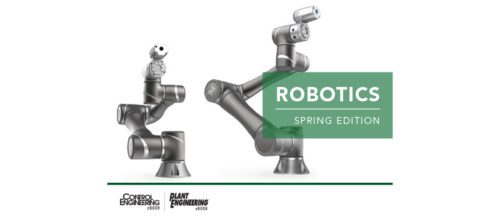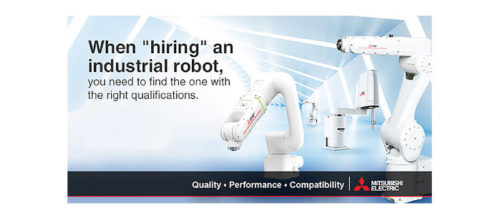Sensors for High-Speed Applications
System design incorporating sensor technology can make in-process and inspection systems faster. Experts in printing/converting, tire/rubber inspection, robotic palletizing, and more provide engineering advice.
LINKS
For more on sensor technology and applications, search “sensors” at www.controleng.com for tutorial articles, videos, and application case histories.
Sidebars: Sample sensors for high-speed applications
Automated high-speed motion applications require high-speed sensor technology to support them. While definitions of “high speed” vary widely — by industry, product line or application — recommendations for the best sensor technology are available. Beyond the advice offered in this article, you can also search “sensors” online at www.controleng.com for links to other sensor technology articles and detailed resources, such as vendor-supplied sensor-selection guides.
Printing/converting applications
Printing and converting machines run at some of the highest speeds of any machines. For these industries, specialists should be relied upon to recommend the right technology for the job. Bill Gilbert, industry business development manager for the converting industry for Siemens, says, “The major high-speed sensor application for converting would be print mark correction. These applications could be performed with rotary knife, flying cutoff, or coating to registration. When selecting a sensor for print mark correction, where input reaction times are typically required in microseconds or less, an optical sensor would be best suited for the task.”
Marcus Schick, Siemens industry business development manager for the printing industry, elaborates. “In commercial printing applications, registration adjustments must often be made in two directions, circumferentially and laterally. Circumferential registration adjustments are made lengthwise with the web (in direction of web motion). Lateral registration adjustments are made across the web (side-to-side). Having one optical sensor that can measure errors in both directions is advantageous,” he says.
Siemens’ Sitrans WS100 speed sensor handles quarry conveyor belts moving at 392 feet per minute.
Schick says Siemens has developed a special optical sensor/camera that is capable of measuring error in both directions and integrating it with a Siemens Simotion controller. “This allows for optimized print registration on difficult applications, like printing on extensible films,” says Schick. “This camera/sensor uses CCD technology with a DSP processor to analyze the picture of the web. It can operate at speeds up to 3,000 feet per minute and the accuracy of measurement is +/- 10 micrometers.” The technology has been employed on presses in Europe, he adds.
Tire and rubber manufacturing
High-speed laser line sensors can detect and quantify defects and dimensional variations in both in-process and final inspection applications. In high volume tire manufacturing, synchronization and communication of sensor data can be a challenge. LMI Technologies, a Canadian research, development, and manufacturing organization specializing in machine vision applied technologies, combined the right sensors with a data integration platform to meet the process’s high-speed requirements.
In tire manufacturing, multiple sensors are often implemented in a single station to cover the full surface of the product with high resolution sensing. LMI Technologies’ Selcom EyeCon high-speed laser line sensors are used to generate masses of data. The process, however, requires tight synchronization of data from all sensors and encoders. LMI’s FireSync platform provides microsecond synchronization between sensors, assembling data from all sensors into a single 3D profile map output to a remote host over a single gigabit Ethernet cable.
Data streams from LMI Technologies’ Selcom EyeCon high-speed laser line sensors are synchronized through LMI’s FireSync platform to create a single 3D profile of tires under inspection.
“A typical inspection application may use multiple laser sensors inspecting different zones of the product, such as calendered rubber, conveyor belts or tread extrusions,” explains Dr. Walter Pastorius, LMI’s technical marketing adviser and a 30-year veteran of the machine vision industry. “An in-process profiling application may use eight or more sensors (half above and half below the conveyor) to provide high data density across the full width of the extrusion” (see graphic).
Typical tire final inspection systems use three high-speed laser line sensors, one inspecting each sidewall and the third inspecting the tread. Each sensor measures hundreds of points along the laser line, at frame rates of 4 kHz or faster, says Pastorius.
“Implementing multiple laser line sensors to cover the full surface of the object creates challenges of synchronizing data from all sensors, and stitching multi-sensor data streams into a single file,” says Pastorius. “Synchronization ensures that data from each sensor is obtained at essentially the same point in time. Otherwise, each sensor’s data will come from a different position along the length of the surface. Stitching involves combining the synchronized profiles from each sensor into a single 3D surface map, transmitted as a single data file to the host.”
The FireSync platform integrates the massive amount of data generated in these applications, data from multiple vision sensors, as well as other local inputs, such as encoders and photocells. The data is sent to the inspection station’s remotely located host computer for analysis using gigabit Ethernet (GigE) communications.
“GigE provides data rates up to 1,000 Mbps, with inexpensive cables running up to 100 meters without repeaters, and Power Over Ethernet (PoE) providing power over the same cable as data transmission, Pastorius explains.
This approach provides very high-speed sensing and data analysis. “Profiles output by all sensors are tightly synchronized within the sensor system itself,” says Pastorius. “Each ‘slice’ of data from all sensors is combined into a single complete 3D data file, sent from the platform over a single GigE output cable to the host computer.”
To improve accuracy, the analysis software also removes or filters out all points that relate to raised lettering, bar codes, and other acceptable variations in the surface. “LMI sensors employ ‘dual triangulation’ with two cameras viewing the laser line, one on either side of the laser projector. This design eliminates data dropouts caused by shadowing of the laser beam at the edges of raised material on the sidewall surface,” adds Pastorius.
Baumer’s Long-Range ParCon sensor, an analog optical line sensor, permits extremely fast and reliable detection of moving parts as small as 0.5 mm. See box below for details.
Vision sensors and robots
Fanuc Robotics America Inc. has an intelligent palletizing robot — the M-410iB —equipped with its iRVision 2D vision sensor for mixed product handling. The M-410iB can handle cases or bags weighing more than 220 lbs. (100 kg) at rates of 20 cycles per minute for boxes, and 28 for bags using a laser vision sensor. The iRVision system has vision software embedded in the robot software, with image processing performed on the robot CPU.
At the June 2009 International Robots & Vision Motion Control Show in Chicago, Fanuc Robotics also demonstrated how speed can be improved by system design. It demonstrated how its M-710iC/50 robot equipped with the iRVision 3DL laser vision sensor could locate and pick randomly piled hubcaps from a storage container. After vision verifies the correct grip position, the robot transfers the part to a second container. iRVision 2D error proofing with high-speed, continuous motion detects defective parts while they’re being moved.
“Fanuc Robotics’ error proofing does 100% inspection for any defective parts or production errors. In addition, error proofing with continuous motion eliminates the impact on cycle time. We’re showing manufacturers how easy and practical robot vision can be, even for bin picking, which has traditionally been a very challenging robotic process,” said Peter Stephan, program manager.
“Traditional error proofing requires the robot to move over the part and stop to inspect for errors,” Stephan continues. “Error proofing while the robot is in motion can further improve the cycle time. The ability to perform inspection on-the-fly is a significant competitive advantage for manufacturers”
The Fanuc iRVision system is a ready-to-use robotic vision package, available on all FANUC robots, requiring only a camera and cable — no additional processing hardware. It has a 2D robot guidance tool to accomplish part location, error proofing, and other operations that normally require special sensors or custom fixtures. Ray Moran, product manager, Fanuc Robotics America Inc., said, “It’s rated best-in-class for speed, and has one of the largest work envelopes in its class.”
For robotic vision processes that exceed the capability of 2D vision systems, FANUC Robotics also offers an integrated 3D vision system.
Error Proofing can be used with iRVision 2D or 3D robot guidance to identify parts, check for part presence or absence, proper orientation or alignment, size and fit, and verify that there is adequate clearance to move parts from one location to another.
Author Information
Renee Robbins is senior editor for Control Engineering. She can be reached at renee.robbins@reedbusiness.com .
Sample sensors for high-speed applications
CCD laser displacement sensors from Keyence provide ultra-high speed sampling of 50 kHz. The LI-CCD model reportedly has a high-speed sampling rate 25 times faster than conventional models. High-speed digital processing of signals from the LI-CCD is performed by a special waveform-processor (digital signal processor), satisfying both high-speed and high-accuracy measurements. Targets traveling, rotating, or vibrating at high speed can be measured reliably, according to the company.
www.keyence.com/products/vision/laser/lkg/lkg_features_2.php
In December 2009, Baumer introduced its Long-Range ParCon sensor, an analog optical line sensor that projects a continuous 24 mm wide beam of parallel light to a reflector. For sensing applications involving distances as far as 200 mm, this unit permits extremely fast and reliable detection of moving parts as small as 0.5 mm. The sensor can also measure object widths regardless of the target’s position in the measuring field. Baumer says the Long-Range ParCon is a cost-effective alternative to light curtain technology because it accurately detects and measures metallic and non-metallic objects at high-speed processing rates up to 1 kHz with resolutions up to 0.1 mm. The unit is designed to accurately detect material edges in applications such as packaging, textile manufacturing, paper production, and printing/graphics. It can also be used in PCB manufacturing, food and beverage packaging, laboratory automation, medical device manufacturing and metalworking applications. Sized at just 67 x 34 x 16.5 mm, the Long-Range ParCon’s housing contains the sender, receiver, and specialty optics; only a reflector is needed to operate it.
www.baumer.com
In March 2009, Siemens announced the release of a compact, medium-resolution belt speed sensor for belt-driven conveyor pulleys. The Sitrans WS100 monitors the belt speed for input to an integrator, which calculates flow rate, total weight, belt load and speed of bulk materials. Typical applications include mineral processing, in particular quarries or cement plants, with belt speeds up to 392 ft/min (2 m/sec). Constructed of polypropylene with type AISI 304 (1.4301) stainless steel sensor mount and cover, the Sitrans WS100 includes corrosion resistant components and rotating targets that are fully sealed. Sitrans WS100 is available in standard and intrinsically safe (IS) versions and is NEMA 4/IP65 rated.
www.sea.siemens.com/ia
The automotive industry, from stamping to powertrain to final assembly, requires a range of high-speed inductive proximity sensors, photoelectric sensors, multiple mechanical switches and RFID systems. Balluff provides these, and also offers pre-engineered, kitted solutions for robot dynamic zone limit applications. Dynamic zone control increases productivity and reduces cycle time by interlocking robot position with light curtains or other presence-sensing devices in a control-reliable manner per ANSI/RIA 15.06-1999. This concept allows the robot to continue working quickly, safely and productively even when operators are present in another part of the robot cell. Balluff systems include a multiple-position safety limit switch housing with prewired connector, a set of diverse complementary redundant cams with configurable zone angles, cam mounting rings, and all miscellaneous hardware. Kits are available for Axis 1, 2, and 3 on many robot models from Fanuc Motoman, Nachi, and others. Balluff also offers linear cam and cam tray components for setting up zone control systems on high-speed robot gantries and robotic transfer units, to control up to eight or more independent zones.
https://www.balluff.com/Balluff/us/ResourcesChannel/Downloads/en/ShortForm.htm
Do you have experience and expertise with the topics mentioned in this content? You should consider contributing to our CFE Media editorial team and getting the recognition you and your company deserve. Click here to start this process.



